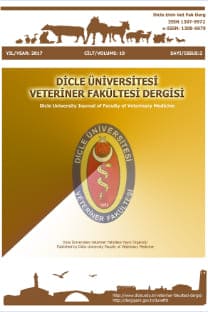Toll-Like Receptor 2 Expression on Ovine Ileum throughout Fetal Development
Fötal gelişim Boyunca Koyun İleumundaki Toll like Reseptör 2 Ekspresyonu
___
1.Hashimoto C, Hudson KL, Anderson KV. (1988). The Toll Gene of Drosophila, Required for Dorsal-Ventral Embryonic Polarity, Appears to Encode a Transmembrane Protein. Cell. 52: 269- 279.2. Medzhitov R, Preston-Hurlburt P, Janeway CA Jr. (1997). A Human Homologue of the Drosophila Toll Protein Signals Acti- vation of Adaptive Immunity. Nature. 388(6640): 394-397.
3. Kawai T, Akira S. (2011). Toll-Like Receptors and Their Cross- talk with Other Innate Receptors in Infection and Immunity. Immunity. 34(5): 637-650.
4. Akira S, Uematsu S, Takeuchi O. (2006). Pathogen Recognition and Innate Immunity. Cell. 124(4):783-801.
5. Cario E. (2008). Barrier-Protective Function of Intestinal Epit- helial Toll-Like Receptor 2. Mucosal Immunol Suppl 1: S62–66.
6. Seong SY, Matzinger P. (2004). Hydrophobicity: An Ancient Damage-Associated Molecular Pattern that Initiates Innate Immune Responses. Nat Rev Immunol. 4(6): 469-478.
7. Arslan F, Keogh B, Mcguirk P, Parker AE. (2010). TLR2 and TLR4 in Ischemia Reperfusion Injury. Mediators Inflamm. 2010: 704202.
8. Piccinini AM, Midwood KS. (2010). Dampening Inflammation by Modulating TLR Signalling. Mediators Inflamm. 2010: 672395.
9. Cario E, Gerken G, Podolsky DK. (2007). Toll-Like Receptor 2 Controls Mucosal Inflammation by Regulating Epithelial Bar- rier Function. Gastroenterology. 132: 1359-1374.
10. Brun P, Giron MC, Qesari M, et al. (2013). Toll-Like Receptor 2 Regulates Intestinal Inflammation by Controlling Integrity of the Enteric Nervous System. Gastroenterology. 145(6): 1323- 1333.
11. Richardson C, Hebert CN, Terlecki S. (1976). Estimation of the Developmental Age of the Ovine Fetus and Lamb. Vet Rec. 99: 22-26.
12. Öztop M, Özbek M, Liman N, Beyaz F, Ergün E, Ergün L. (2019). Localization Profiles of Natriuretic Peptides in Hearts of Pre- Hibernating and Hibernating Anatolian Ground Squirrels (Spermophilus Xanthoprymnus). Vet Res Commun. 43(2): 45- 65.
13. Özbek M, Bayraktaroğlu AG. (2019). Developmental Study on the Ileal Peyer's Patches of Sheep, and Cytokeratin-18 as a Possible Marker for M Cells in Follicle Associated Epithelium. Acta Histochem. 121(3): 311-322.
14. Moncada DM, Kammanadiminti SJ, Chadee K. (2003). Mucin and Toll-Like Receptors in Host Defense against Intestinal Pa- rasites. Trends Parasitol. 19(7): 305-311.
15. Cario E, Podolsky DK. (2000). Differential Alteration in Intesti- nal Epithelial Cell Expression of Toll-Like Receptor 3 (TLR3) and TLR4 in Inflammatory Bowel Disease. Infect Immun. 68(12): 7010-7017.
16. Cario E, Rosenberg IM, Brandwein SL, Beck PL, Reinecker HC, Podolsky DK. (2000). Lipopolysaccharide Activates Distinct Sig- naling Pathways in Intestinal Epithelial Cell Lines Expressing Toll-Like Receptors. J Immunol. 164(2): 966-972.
17. Kosik-Bogacka DI, Wojtkowiak-Giera A, Kolasa A, Salamatin R, Jagodzinski PP, Wandurska-Nowak E. (2012). Hymenolepis Di- minuta: Analysis of the Expression of Toll-Like Receptor Genes (TLR2 and TLR4) in the Small and Large Intestines of Rats. Exp Parasitol. 130(3): 261-266.
18. Ortega-Cava CF, Ishihara S, Rumi MA, et al. (2003). Strategic Compartmentalization of Toll-Like Receptor 4 in the Mouse Gut. J Immunol. 170(8): 3977-3985.
19. Inoue R, Yajima T, Tsukahara T. (2017). Expression of TLR2 and TLR4 in Murine Small Intestine during Postnatal Development. Biosci Biotechnol Biochem. 81(2): 350-358.
20. Yang Z, Fu Y, Gong P, et al. (2015). Bovine TLR2 and TLR4 Me- diate Cryptosporidium Parvum Recognition in Bovine Intesti- nal Epithelial Cells. Microb Pathog. 85:29-34.
21. Kanai M, Rosenberg I, Podolsky DK. (1997). Cytokine Regula- tion of Fibroblast Growth Factor Receptor 3 IIIb in Intestinal Epithelial Cells. Am J Physiol. 272(4): G885-G893.
22. Ng AY, Waring P, Ristevski S, et al. (2002). Inactivation of the Transcription Factor Elf3 in Mice Results in Dysmorphogenesis and Altered Differentiation of Intestinal Epithelium. Gastroen- terology. 122(5): 1455-66.
23. Hausmann M, Kiessling S, Mestermann S, et al. (2002). Toll- Like Receptors 2 and 4 Are Up-Regulated during Intestinal Inf- lammation. Gastroenterology. 122(7): 1987-2000.
24. Yuasa H, Mantani Y, Masuda N, et al. (2017). Differential Expression of Toll-Like Receptor-2, -4 and -9 in Follicle- Associated Epithelium from Epithelia of Both Follicle- Associated Intestinal Villi and Ordinary Intestinal Villi in Rat Peyer's Patches. J Vet Med Sci. 78(12): 1797-1804.
25. Filippova LV, Malyshev FS, Bykova AA, Nozdrachev AD. (2012). Expression of Toll-Like Receptors 4 in Nerve Plexuses of the Rat Duodenum, Jejunum, and Colon. Dokl Biol Sci. 445: 215- 217.
26. Ammoscato F, Scirocco A, Altomare A, et al. (2013). Lactobacil- lus Rhamnosus Protects Human Colonic Muscle from Patho- gen Lipopolysaccharide-Induced Damage. Neurogastroenterol Motil. 25(12): 984-E777.
27. Brun P, Gobbo S, Caputi V, et al. (2015). Toll Like Receptor-2 Regulates Production of Glial-Derived Neurotrophic Factors in Murine Intestinal Smooth Muscle Cells. Mol Cell Neurosci. 68 : 24-35.
28. Turco F, Sarnelli G, Cirillo C, et al. (2014). Enteroglial-Derived S100B Protein Integrates Bacteria-Induced Toll-Like Receptor Signalling in Human Enteric Glial Cells. Gut. 63(1): 105-115.
- ISSN: 1307-9972
- Yayın Aralığı: Yılda 2 Sayı
- Başlangıç: 2008
- Yayıncı: Dicle Üniversitesi Veteriner Fakültesi
Kekliklerin Ovaryum ve Testis Dokularında Bazı Metabolik Hormonların Dağılımı
Uğur TOPALOĞLU, MEHMET ERDEM AKBALIK, Hakan SAĞSÖZ, Muzaffer Aydın KETANİ, BERNA GÜNEY SARUHAN
Van ve Bitlis İllerindeki Köpeklerde Leishmaniasis Seroprevalansı
AHMET HAKAN ÜNLÜ, Erkan DÜZ, HÜSEYİN BİLGİN BİLGİÇ, Onur KÖSE, SERKAN BAKIRCI
Yavru Bir Kedide Femoral Kondroblastik Osteosarkom: Olgu sunumu
Hilmi NUHOĞLU, Emin KARAKURT, Serpil DAĞ, Uğur YILDIZ, Uğur AYDIN, Sadık YAYLA
Trakya At Irkında Serum Visfatin Seviyesi Üzerine Yaş, Cinsiyet, Mevsim Etkisinin İncelenmesi
Kompost Yekpare Yataklı Ahırlar
ROMEDİ ÇELİK, Berna ERSÖZ KANAY, AKIN KOÇHAN
İvesi Koyunlarda (Ovis aries) Bulbus Oculinin Makroanatomik ve Morfometrik Yapısı
İsmail DEMİRCİOĞLU, Bestami YILMAZ
Toll-Like Receptor 2 Expression on Ovine Ileum throughout Fetal Development
MEHMET ÖZBEK, EMEL ERGÜN, LEVENT ERGÜN, FEYZULLAH BEYAZ, Füsun ERHAN, Banu KANDİL, Nuh YILDIRIM, ÖZGE ÖZGENÇ
Kanatlı Sindirim Sisteminin Fonksiyonel Histolojisi
Yağmur Raziye KOÇAK, Tuğba ÖZAYDIN
EMİN KARAKURT, HİLMİ NUHOĞLU, BARIŞ SARI, SERPİL DAĞ, ATİLA AKÇA, ENVER BEYTUT
